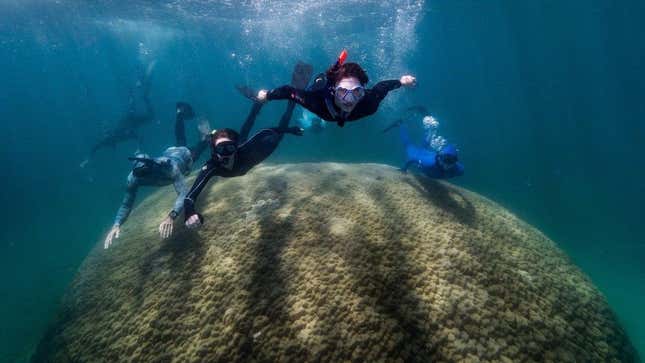
Snorkelers swimming in Australia’s Great Barrier Reef have stumbled upon a coral of epic proportions. Composed of living organisms, the gigantic mass is the widest coral ever found in the region and one of the oldest.
The coral, discovered this past March, measures 17.4 feet (5.3 meters) tall and 34.1 feet (10.4 meters) wide. That makes it the widest single coral structure and the sixth tallest in Australia’s Great Barrier Reef, according to new research published in Scientific Reports. The coral is nearly 8 feet wider than the previous record holder in the Great Barrier Reef. Adjunct associate professor Adam Smith from James Cook University led the new research.
Recreational snorkelers found the coral while swimming off the coast of Goolboodi island, a member of Queensland’s Palm Island Group. The coral, a happy conglomeration of tiny marine animals and calcium carbonate, sits in a protected area that rarely gets any visitors. Traditional owners of this territory, the Manbarra people, were consulted by the researchers, and chose to name the coral Muga dhambi, which translates to “big coral.”

Smith and his colleagues scoured through the available literature and talked to other scientists to acquire a better understanding of the coral and how it compares to others. The natural structure belongs to the Porites genus—a group of coral known for its tremendous size. These corals can be found in Japan, Taiwan, and American Samoa, the latter region being home to an absolutely colossal Porites colony measuring 26.3 feet (8 meters) tall and 73.5 feet (22.4 meters) at its widest point.
Often brown and cream in color, Porites coral is built from small, stone-like polyps, which “secrete layers of calcium carbonate beneath their bodies as they grow, forming the foundations upon which reefs are built,” as Smith, along with study co-authors Nathan Cook, a marine scientist from Cook University, and Vicki Saylor, a Manbarra Traditional Owner with indigenous knowledge, wrote in an article prepared for The Conversation.
Approximately 70% of the structure is live coral, with the remaining 30% consisting of green boring sponge, turf algae, and green algae, according to the study. Living coral “can die from exposure to sun at low tides or warm water, and dead coral “can be quickly colonised by opportunistic, fast growing organisms, as is the case with Muga dhambi,” the authors wrote in The Conversation.
At somewhere between 421 and 438 years old, Muga dhambi is old in addition to being big. The age estimate was derived by calculating coral growth rates and yearly sea surface temperatures. The oldest known coral in the Great Barrier Reef is 436 years old, so Muga dhambi is right there along with it in terms of age. As the authors point out, Muga dhambi is a survivor, having withstood upwards of 80 major cyclones over the years. This hardy coral has managed to stay safe from invasive species, coral bleaching episodes (the scientists found no evidence of bleaching), low tides, and—at least so far—human activities.
Muga dhambi appears to be healthy, but human-caused climate change, poor water quality, and other factors threaten this coral and the Great Barrier Reef in general. The scientists are asking traditional owners and others to monitor the coral in hopes that it will continue to thrive for many more generations.
More: Freakishly tall coral reef found off the coast of Australia.